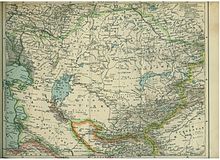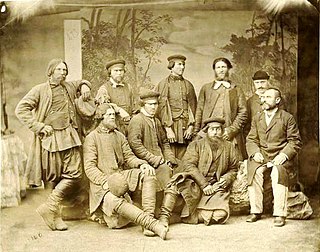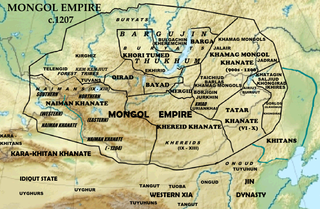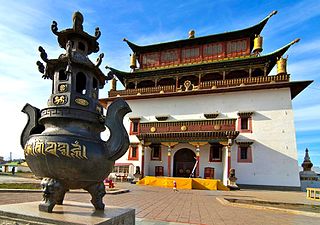Christianity in Kazakhstan is the second most practiced religion after Islam and one of the major religions of Kazakhstan.
| Christianity by country |
|---|
 |
| |
Christianity in Kazakhstan is the second most practiced religion after Islam and one of the major religions of Kazakhstan.
The 2021 census noted that Kazakhstan is 17.19% Christian, 69.31% Muslim, 11.25% other religious beliefs and 2.25% no religious belief. [1] [2]
Other figures suggest that 24% of the population is Orthodox, 1% is either Protestant or Catholic and 1% belongs to other Christian denominations. [3]
In 2022, the government considered several religions as 'traditional', including Hanafi Sunni Islam, the Russian Orthodox Church, Greek and Roman Catholicism, Lutheranism, and Judaism. [4]
In 2009, the majority of Christian citizens were Russians, Ukrainians and Belarusians, who belong to the Eastern Orthodox Church in Kazakhstan under the Moscow Patriarchate. About 1.5 percent of the population is ethnically German, most of whom are Catholic or Lutheran. Other Christian groups included Presbyterians, Jehovah's Witnesses, Seventh-day Adventists, Baptist (Union of Evangelical Christian Baptists of Kazakhstan) and Pentecostals, [5] Methodists, Mennonites, and Mormons. [6]

According to the 2009 Census, there were 4,214,232 Christians in Kazakhstan. Their ethnic affiliation is as follows: [7]

Before the conquest of Genghis Khan there used to be a minority of Nestorians in the Kazakh region. A bishop's see existed in the town of Merv in the year 334 and Nestorians were in the country when Marco Polo arrived in the late 13th century. [8] [9]
By the time Kazakhstan was conquered by Genghis Khan, most of the Naimans were Christians. They remained so after the Mongol conquest and were among the second wave of Christians to enter China with Kublai Khan. [10] Meanwhile, the Naimans who settled in the Western Khanates of the Mongol Empire were all eventually converted to Islam.
A Franciscan monk, William of Rubruck travelled around Kazakhstan in 1254. He met Möngke Khan and Sartaq Khan (great-grandson of Genghis Khan); both men converted to Christianity. A few years later Pope Nicholas III established the Diocese of Kipciak. [11]
Russian Orthodoxy arrived in the country in the 18th and 19th centuries. [12]
Incorporation into the Soviet Union led to decades of Communist Party controls including confiscation of church property, control of education, and the detention and execution of clergy. Political independence in 1991 led to more people taking an interest in religion, as they were now able to read and discuss matters of spirituality; this also led to a rise in the number of citizens identifying as Christians in the 1990s and the early 2000s. [13]
A 2015 study estimates that some 50,000 Christians from a Muslim background reside in the country. [14]
The Christian mission group Open Doors ranks Kazakhstan as the 47th worst country in the world to be a Christian. [15]

The Molokans are a Russian Spiritual Christian sect that evolved from Eastern Orthodoxy in the East Slavic lands. Their traditions, especially dairy consumption during Christian fasts, did not conform to those of the Russian Orthodox Church, and they were regarded as heretics. The term Molokan is an exonym used by their Orthodox neighbors. Members tend to identify themselves as Spiritual Christians.

Religion in the Union of Soviet Socialist Republics (USSR) was dominated by the fact that it became the first state to have as one objective of its official ideology the elimination of existing religion, and the prevention of future implanting of religious belief, with the goal of establishing state atheism (gosateizm). However, the main religions of pre-revolutionary Russia persisted throughout the entire Soviet period and religion was never officially outlawed. Christians belonged to various denominations: Orthodox, Catholic, Baptist and various other Protestant denominations. The majority of the Muslims in the Soviet Union were Sunni, with the notable exception of Azerbaijan, which was majority Shia. Judaism also had many followers. Other religions, practiced by a small number of believers, included Buddhism and Shamanism.

The Naiman were a medieval tribe originating in the territory of modern Western Mongolia, and are one of the tribes of modern Mongols and in the middle juz of the Kazakh nation.

The Keraites were one of the five dominant Mongol or Turkic tribal confederations (khanates) in the Altai-Sayan region during the 12th century. They had converted to the Church of the East (Nestorianism) in the early 11th century and are one of the possible sources of the European Prester John legend.

Moldova's constitution provides for freedom of religion and complete separation of church and state, though the constitution cites the "exceptional importance" of Eastern Orthodox Christianity. Discrimination on the basis of religious affiliation is illegal, and incitement to religious and ethnic hatred was made illegal in May 2022. Religion in Moldova is dominated by the Eastern Orthodox branch of Christianity. According to the 2014 Moldovan census, 90 per cent of the country reported to be of the Eastern Orthodox Christian faith. Of this number, around eighty to 90 per cent of Orthodox Moldovans belong to the Moldovan Orthodox Church which is subordinate to the Russian Orthodox Church, and has played a powerful role in deepening Russia's influence in Moldova. The remaining 10–20 per cent of Orthodox Moldovans belong to the Metropolis of Bessarabia, which is subordinate to the Romanian Orthodox Church.

Tengrism is a religion originating in the Eurasian steppes, based on shamanism and animism. It generally involves the titular sky god Tengri, who is not considered a deity in the usual sense but a personification of the universe. According to some scholars, adherents of Tengrism view the purpose of life to be in harmony with the universe.

The Catholic Church in Kazakhstan is part of the worldwide Catholic Church, under the spiritual leadership of the pope in Rome.

Christianity in Mongolia is a minority religion. In 2020, Christians made up 1.94% of the population.

Islam in Mongolia is practiced by approximately 3 to 5% of the population. It is practised by the ethnic Kazakhs of Bayan-Ölgii Province and Khovd Province aimag in western Mongolia. In addition, a number of small Kazakh communities can be found in various cities and towns spread throughout the country. Islam is also practiced by the smaller communities of Khotons and Uyghurs.
Kuchlug was a member of the Naiman tribe who became the last emperor of the Western Liao dynasty. The Naimans were defeated by Genghis Khan and he fled westward to the Qara Khitai, where he became an advisor to his future father-in-law Yelü Zhilugu. He later rebelled, usurped the throne and took control of the empire, putting an end to the rule of the House of Yelü. He was killed in 1218 by the Mongols and the domain of the Qara Khitai was absorbed into the Mongol Empire.

Religion in Mongolia has been traditionally dominated by the schools of Mongolian Buddhism and by Mongolian shamanism, the ethnic religion of the Mongols. Historically, through their Mongol Empire the Mongols were exposed to the influences of Christianity and Islam, although these religions never came to dominate. During the communist period of the Mongolian People's Republic (1924–1992) all religions were suppressed, but with the transition to the parliamentary republic in the 1990s there has been a general revival of faiths.

In modern times the Mongols are primarily Tibetan Buddhists, but in previous eras, especially during the time of the Mongol empire, they were primarily shamanist, and had a substantial minority of Christians, many of whom were in positions of considerable power. Overall, Mongols were highly tolerant of most religions, and typically sponsored several at the same time. Many Mongols had been proselytized by the Church of the East since about the seventh century, and some tribes' primary religion was Christian. In the time of Genghis Khan, his sons took Christian wives of the Keraites, and under the rule of Genghis Khan's grandson, Möngke Khan, the primary religious influence was Christian.

Christianity in Asia has its roots in the very inception of Christianity, which originated from the life and teachings of Jesus in 1st-century Roman Judea. Christianity then spread through the missionary work of his apostles, first in the Levant and taking roots in the major cities such as Jerusalem and Antioch. According to tradition, further eastward expansion occurred via the preaching of Thomas the Apostle, who established Christianity in the Parthian Empire (Iran) and India. The very First Ecumenical Council was held in the city of Nicaea in Asia Minor (325). The first nations to adopt Christianity as a state religion were Armenia in 301 and Georgia in 327. By the 4th century, Christianity became the dominant religion in all Asian provinces of the Eastern Roman Empire.

Christianity in Uzbekistan is a minority religion.
According to various polls, the majority of Kazakhstan's citizens, primarily ethnic Kazakhs, identify as Sunni Muslims. In 2020, Shia Muslims made up 0.55% of the population.
The 2021 census noted that Kazakhstan is 69.31% Muslim, 17.19% Christian, 11.25% other religious beliefs and 2.25% no religious belief.

Christianity has a long history in Kyrgyzstan, with the earliest archaeological remains of churches belonging to the Church of the East in modern-day Suyab dating back to the 7th century. By the 9th century an archdiocese of the Church of the East cared for the Christians of Kyrgyzstan and adjacent areas in eastern Turkestan. Although primarily Turkic there was also an Armenian community in what today is Kyrgyzstan by the 14th century. By the 15th century, however, there were no longer ecclesiastical structures of any church caring for what is today Kyrgyzstan and Islam gained the ascendancy amongst the Kyrgyz people.

The Mongols were highly tolerant of most religions during the early Mongol Empire, and typically sponsored several at the same time. At the time of Genghis Khan in the 13th century, virtually every religion had found converts, from Buddhism to Eastern Christianity and Manichaeanism to Islam. To avoid strife, Genghis Khan set up an institution that ensured complete religious freedom, though he himself was a Tengrist. Under his administration, all religious leaders were exempt from taxation, and from public service. Mongol emperors were known for organizing competitions of religious debates among clerics, and these would draw large audiences.
The Eastern Orthodox Church in Kazakhstan is a metropolitan district or metropolia of the Russian Orthodox Church. Although not autonomous or fully self-governing like the Ukrainian Orthodox Church under the Moscow Patriarchate, the Church in Kazakhstan has been given some self-government, with jurisdiction over all Orthodox Christians in Kazakhstan. Most of its members are ethnic Russians, Ukrainians, Koreans, and Belarusians resident in Kazakhstan.
{{cite web}}: CS1 maint: archived copy as title (link)